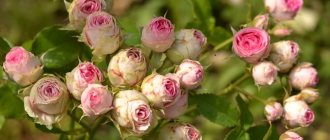Diseases, pests and ways to combat them
Roses may be susceptible to the following diseases:
- Gray rot. It affects buds with pedicels, which are covered with a white coating. Roses with light flowers are most often affected by this. A gliocladin tablet placed under the plant in May and August will cope with this.
- Infectious burn. Overtakes the plant after removing the cover. A bright red ring appears on the shoots, turning black. Over time it dies off. The diseased shoot is cut off to the healthy part and treated with the drug “RanNet”.
Aphids, scale insects, caterpillars, May beetles, and pennies can harm the bush. They are eliminated using manual sampling.
Rose lovers will appreciate this variety. If you provide it with proper care, you can count on prolific flowering.
Pests
Microscopic spiders have appeared on the plant, and the rose is gradually becoming covered with cobwebs, what should I do?
Spider mite
Are small green insects destroying your rose? Effective methods of pest control.
Green rose aphid
Caterpillars have appeared on the rose and are twisting the leaves of the plant, how to deal with the pest
Rose leaf roller
Flat bumps have appeared on the shoots of the rose or on the underside of the foliage, how to deal with the pest
Rosen scale insect
Rose blossom
The White Meidiland rose is a repeat-blooming variety. The flowering process occurs from spring until autumn in two distinct waves. Abundant flowering occurs in the first wave; leaves are practically invisible. During the second wave, long shoots (1.1 m) appear, which subsequently droop due to the weight of the blooming flowers.
Re-blooming is ensured by summer pruning. It is necessary to get rid of faded flowers. This stimulates growth and the appearance of more buds.
Important! After flowering in the fall, overgrown rose bushes should be trimmed and branches infected with fungi should be removed. This will help rejuvenate the plant, prevent the development of diseases, and improve its decorative appearance.
Why it doesn’t bloom and what to do
The ground cover rose Blank Meyandecor may not bloom due to improper care, poor planting location, unsuitable climate, or infection with fungal diseases. You can solve the problem by transplanting the plant to another place, properly pruning it and treating it with antifungal agents.
How to choose a variety
Today, you can find many climbing white roses on the market for goods and services. However, when making a purchase, it is important to understand that such varieties have many similarities with climbing rose hips, which, among other things, are a close relative of roses. It is this relationship that allows unscrupulous sellers to offer rose hips to sellers, passing them off as bushes of white climbing roses. In order not to be deceived, it is recommended to inspect the purchased bushes as carefully as possible. Thus, rose hips will have young shoots of a rich green hue, while white climbing roses will have dark red shoots.
Attention! Many varieties, due to their high growth, need a garter and support.
Advantages of the rose "Nadya Meyandekor"
Undoubtedly, the rose “Nadya Meyandekor” deserves to live in the garden, since it meets all the expectations of rose growers. It tolerates recurrent spring frosts, summer heat and autumn cold well. Its dense bush is resistant to infectious diseases of roses and damage by pests. Winters well in the climatic conditions of the middle zone, although this rose is classified in zone 6.
For a ground cover rose with a prostrate bush height of about half a meter, an adult plant “Nadya Meyandekor” has rather large, densely double flowers (9-10 cm in diameter). At the ends of the stems and on the growing side branches of its drooping long (80-100 cm) shoots, 3-5 oval buds are formed simultaneously. As a result, each shoot is constantly covered with new buds and flowers at different stages of dissolution.
The buds open slowly and the blooming flowers are very beautifully shaped. Charming flowers that remain decorative for a long time look great against the backdrop of numerous bright green leaves shining in the sun. Blooming early at the very beginning of summer, the spreading rose bush “Nadya Meyandekor” blooms continuously and profusely until the end of the garden season, until the onset of significant frost.
Rose Blanc Meyandecor or Maidiland
The variety was first bred in 1987 in France. Rose White Maidiland is a spreading bush with thick, stiff shoots of a light green hue. According to the description, the height of the plant can reach a maximum of 140 cm. The width varies between 120-215 cm.
Double rose flowers are white with a slightly pinkish edge. They gather in inflorescences of 5-10 pieces. Each flower has about 60-70 petals. The size of the flower is 7-9 cm. The aroma of the flower is weakly expressed.
Rose Blanc Meillandecor
Large glossy leaves of a typical shape have a dark green color. The stems are strewn with a large number of thorns. This rose bush is great for growing in a container or on the lawn. The plant can be used as a ground cover, decorating the garden. Its advantages include resistance to frost and rainy weather, long-term repeat flowering.
Important! The plant has good resistance to diseases such as powdery mildew and black spot
Rosa Blanc in landscape design
Appearance and features
The shape and appearance of the Ohara White rose resembles a marshmallow. The wide, smooth petals are snow-white at the edges and have a pale pink tint at the core. The petals are densely packed, in the center they are pressed tightly against each other, the edges are framed by several large pointed leaves turned outward.
The rose is ideal for cutting, so its shoots are smooth and thin, and there are few thorns on the stems. The shrub is covered with dark green glossy round leaves. The plant is tall and neat. The dark leaves of the shoots contrast with the light white roses.
Care instructions
The varieties described above are quite unpretentious in care. They are very weakly susceptible to disease, recover well from mechanical damage and do not need frequent watering.
Note! These plants take root in almost any soil, as long as it is not very acidic. For planting in the garden, a sunny, not too windy place at a distance of 2-3 meters from other plants is suitable, since these roses can fill someone else’s territory with their shoots
Therefore, periodically, usually in the spring, they should be pruned and thinned.
For planting in the garden, a sunny, not too windy place at a distance of 2-3 meters from other plants is suitable, since these roses are capable of filling someone else’s territory with their shoots. Therefore, periodically, usually in the spring, they should be pruned and thinned.
High frost resistance from -40 to -20°C allows these varieties to not need shelter for the winter.
Important! Standard roses must be covered for the winter. https://www.youtube.com/embed/hoRgN-AEIZg
Useful tips
- Bouquets of Ohara White roses look good in single arrangements. Ribbons and stems of green herbaceous plants are used as decoration;
- The variety is perfect for decorating a wedding celebration; with its help you can create the perfect bridal bouquet or boutonniere for the groom;
- To grow roses on a plot, it is recommended to choose sunny areas, but it is undesirable for flowers to be exposed to scorching rays for a long time, so the crop should be in the shade for several hours a day;
Rose blossom
In order for a crop to bloom beautifully, you need to provide it with quality care. It must have an integrated approach.
Period of activity and rest
The culture is characterized by lush flowering, which begins in June and ends in October. Throughout the summer, buds form on the plants. According to gardeners' descriptions, the flowering resembles the Topala rose.
Care during and after flowering
In order for a culture to develop normally, it must be properly cared for. During the formation of buds, roses require potassium and phosphorus. To preserve the decorative appearance of the bushes, you need to immediately remove the faded buds.
What to do if it doesn't bloom
The lack of flowering may be due to the following factors:
- nutritional deficiencies;
- improper watering;
- thickening of plantings.
The use of white roses in landscape design and gardening
Rose varieties with white petals are suitable for creating arrays of roses. Moreover, they can be created either in one color or in combination with roses of other colors. Plantings where bushes with white flowers are combined with soft pink, soft yellow, peach and soft lilac look very gentle and elegant.
Combinations of white roses with red, purple, orange, blue, violet and almost “black” varieties are effective and contrasting. When selecting plants for flower beds, garden beds, groups and containers, it is worth considering that some white roses may have a slight tint (orange, green, yellow), which disappears during flowering.
Also, the buds of such varieties can be of a certain shade, but when they bloom they become white. These small color nuances must be taken into account so that the combination of colors is harmonious and does not irritate the eyes.
White roses are perfect for creating a monochrome garden (one color). When creating such a project, plants are combined with various perennial crops, trees and shrubs, painted in white and white-green tones. We are sure that the above photos and names of varieties of white roses will inspire you to create interesting compositions in the garden.
White Meidiland
White Meidiland, White Meilland (White Medyand)
Meilland France, 1987
Shrub
Description:
Can be cultivated as ground cover.
The flowers are white with a slightly pinkish edge of 60-70 petals, double, medium size, 6-9 cm, collected in inflorescences of 5-10 pieces. The leaves are large, dark green, shiny. The bush is spreading (width may exceed height). The shoots are thick, light green, hard, with numerous light thorns. Completely frost-resistant, profusely and long-flowering variety. The aroma is very weak or absent. An excellent plant for planting in lawns and containers.
Flower diameter, cm: 7-9
Bush dimensions (h*w, cm): 90-140*120-215
Resistance to fungal diseases: highly resistant
Flowering: re-blooming
Reviews from experienced rose growers:
Hardy, very beautiful white rose! (no pink around the edges was noticed - snow-white, without color changes), fluffy, neat, powerfully growing bush; The flowers have a very beautiful fluffy shape, they don’t show the middle, they last a very long time even in the hot sun! The foliage is dark, glossy - a wonderful background for them, always elegant and somehow cheerful! It so happened that 2 times, in August, it was still blooming, and in the spring, in a hurry, I had to replant it... it didn’t disappoint! and overwintered (at -20 only under the hill and a layer of grass) and will bloom for the second time (the flowers from the first flowering, quite presentable, were forcibly pruned so that the bush develops). According to the description, she is a shrub, I would argue... if she is a shrub, then it is not the classic low one, but closer to floribundas with slopes towards ground cover, because the bush is very compact, dense, fluffy, grows harmoniously in width and is all covered with flowers. Therefore, it is perfect for both the foreground and for a good dense border, if necessary. (Bandurina Yulia Valentinovna, Minsk)
I have had this rose for 4 years, it is winter-hardy, it has never been sick with anything, it blooms in two distinct waves, the first is the most abundant, the leaves are almost invisible. There are always buds and flowers between the waves. In the second half of summer, it shoots upward with long shoots, about 1.1 m, which gradually droop under the weight of the blooming flowers. The flower lasts a long time. Tolerates heat well. Grows in full sun. Height approximately 60cm, width 1.20. Self-cleaning, but sometimes the fading flowers turn brown around the edges, I don’t like it, so I tear it off. My rose has no scent at all. (Ulizko Irina Aleksandrovna, Volgograd)
This rose is a PERFECT WHITE GROUNDCOVER! Rose has a lot of advantages: quite large flowers, always absolutely white, they are not afraid of heat, as well as rain, they last a long time and bloom neatly. The foliage is simply a sight to behold: not small, very beautiful, glossy and not just dark green, but even with notes of “malachite” and the white flowers only emphasize it even more. Not a single diseased leaf was noticed during the season! Nothing but delight! (Loginova Nadezhda Nikolaevna, northern Moscow Region)
Wonderful rose!!! Favorite!!! It actually overwinters very well, does not get sick, and blooms in large clusters of up to 10 flowers, or even more. I admire the bloom of this rose!!!! (Oksana Dmitrievna, Kodyma, Odessa region)
Varieties of white roses (photos and names)
Roses of white shades of different groups require different planting areas, and the habit of the bushes varies greatly. Therefore, when creating garden compositions, it is necessary to take into account not only the shades of the petals, but also the growth characteristics of the bushes and their flowering frequency.
Let us list some varieties of white roses (both old famous ones and new ones) that can be found in specialized companies and nurseries in the Russian Federation and the CIS.
varieties of white roses with descriptions and photos (table)
| Variety | Description |
| Hybrid tea white roses | |
| The White Christmas variety was developed in 1953 in the USA. The narrow bushes are formed by rather tall, strong shoots from 80 to 100-110 cm long, which look straight up. The dense leaves with a leathery surface are painted in a pleasant salad green hue. Double flowers, 10 to 12 cm wide, bloom from beautifully shaped buds consisting of 40 petals. There are usually from 1 to 3 flowers on one shoot. The pronounced aroma also attracts attention. Lush flowering lasts almost all summer | |
| The Pascali variety was obtained in Belgium in 1963 and is still very popular for its unpretentiousness and durability, as well as for its beauty and lush flowering. This variety holds the title of "The World's Most Favorite Rose", which was awarded in 1991. Tall bushes are formed by erect shoots covered with large leaves of dense green color. Their height ranges from one and a half to 1.75 meters. At the ends of strong shoots there is one slowly opening white flower with a cream-colored base, which then becomes snow-white | |
| The variety "Metropolitan" was bred in France in 2004 by Alain Meillan. Quite narrow, but tall bushes are formed by strong, straight shoots, which are covered with a large number of dark green leaves with a slight shine. Elongated buds with slightly bent edges of the petals have a beautiful shape. Double flowers (number of petals from 20 to 40) are most often located one at a time at the ends of the shoots. The aroma with hints of peach, apricot, lily and banana can be felt even from a distance | |
| White roses Grandiflora | |
| The Mount Shasta variety was created in the USA in 1963 and, although many years have passed, this white rose is still one of the best. Powerful bushes are formed by long shoots looking up. Their height can vary from 100 to 110-120 cm. The leaves with a leathery surface, painted in a grayish-green tint, give the bush a beautiful appearance. Large buds have a pointed end and consist of 20-25 petals. The color of the flower, 12 to 13 cm wide, is whiter than that of the Pascali variety. The flowers are located on the shoots mainly one at a time, which helps to use this variety for cutting. The flowers give off an attractive aroma | |
| White roses of the Floribunda group | |
| The La Paloma variety was created in Germany. Small bushes from half a meter to 0.6 meters in height are formed by branched powerful shoots. They are covered with dark green foliage. Large flowers, seven to eight centimeters wide, are arranged in racemes of three to five to nine pieces. At the beginning of flowering, the flowers are painted in a light cream shade and with a soft lemon center, but then they become almost snow-white. Good resistance to diseases | |
| The White Roadrunner variety was obtained in 2001 in Germany. Dense bushes, reaching a height of about half a meter, are formed by spectacular shoots with a large number of branches. The beautiful appearance is complemented by dense, slightly leathery leaves, painted in a thick green tint. Their special advantage is that they are not affected by diseases. The strongly scented white flowers, about five centimeters wide, bloom in raceme-like inflorescences in several waves per season. The number of flowers in an inflorescence can vary from five to ten pieces | |
| The White Bouquet / Korsnoda variety was bred in 2007 in Germany. Low bushes, consisting of fairly strong, well-branched shoots, can reach up to half a meter. Double flowers four to five cm wide bloom in inflorescences consisting of three to five pieces. Lush flowering continues throughout the warm season. Has strong resistance to powdery mildew | |
| White roses - scrubs | |
| The Ice Meillandecor variety was created in 1996 by the famous French company Meillanov. A small, but very powerful and wide bush is formed by shoots about 70-80 cm long (can be longer), which have a huge number of thorns. The advantage of this variety is that the shoots along the entire length are covered with a large number of green leaves, which persist for a long time. Semi-double flowers about five or six centimeters wide bloom in raceme-type inflorescences, which contain from five to ten pieces. | |
| Ground cover white roses | |
| The variety "Arctic" was obtained in 2004 in Germany. The bushes are about 60 cm high and reach a width of almost 1.2 meters. The shoots are covered with beautiful leaves of a dense green hue with a glossy upper part. Moreover, each sheet consists of seven leaflets. Small double white flowers, odorless, four to five centimeters wide, form inflorescences consisting of 10-15 pieces. They bloom from orange buds. The lifespan of a flower is about 8 days | |
| The Nemo variety was bred in 2001 in Germany. Wide bushes from 0.8 to one meter in height consist of gracefully inclined and branched shoots, covered with foliage with a glossy bright green color. Single flowers, about 4 cm wide, are painted white. The decoration of the flower is a large number of stamens with yellow anthers in the middle. Flowers open from soft pink buds in panicle-type inflorescences, where there are from five to ten pieces | |
| The variety "Swan Carpet" (Snow Cover) was obtained in 1992 in Denmark. Low and very wide bushes reach a height of 40 to 1 meter. The width can reach up to two meters. Very small white semi-double flowers range in width from three to four centimeters. They bloom in large quantities on a bush of pinkish buds. At first the flowers have a slight pink tint, but quickly turn white. They are collected five to ten pieces in inflorescences. This variety attracts attention with its lush flowering, which is practically uninterrupted. | |
| Climbing white roses | |
| The Long John Silver variety was created back in 1934 in the USA, but to this day it stands out among other climbing roses in terms of growth capacity and bush size. A very tall and spreading bush can reach 3-5 meters in height and up to 3 meters in width. Long, poorly bending shoots, covered with a huge number of large spines, form an erect bush. The rounded shape of the large and slightly convex leaves is also interesting. The lower part of the shoots is exposed and does not look very beautiful. Densely double flowers, 9 to 11 cm wide, are painted in a beautiful white shiny shade. They are located in fairly dense raceme-type inflorescences of 3-5 pieces. May bloom again | |
| The Thalia variety was developed in France in 1895, but was later bought by Lambert. Vigorous bushes, reaching a height of 3 to 4 meters and a width of up to 2.5 meters, are distinguished by early flowering. Slightly inclined and branched shoots are covered with attractive green leaves and a small number of spines. Very impressive are simply huge umbrella-type flower caps, consisting of many white semi-double flowers with a delicate aroma (from 20 to 100 pieces). Easily propagated by cuttings | |
| The White Dorothy variety was obtained in 1908 in England. Quite powerful and large bushes from two to three meters high are formed by slightly branched, slightly curving shoots. White flowers with an almost imperceptible aroma, 4 to 5 cm wide, open in racemes, where there are from five to ten pieces. Usually blooms once per season. Can be very sick with powdery mildew | |
| Miniature white roses | |
| The Blanca Parade variety was created in 2001 in Denmark. Very small bushes, slightly rounded in shape and 30 to 40 cm high, are formed by branched shoots that are covered with beautiful leaves of bright green color. The semi-double flowers are three to four centimeters wide and have a whitish-cream hue. One to three flowers are usually formed on one shoot. Lush flowering repeats throughout the summer. This variety reproduces well using cuttings | |
| The White Meillandina variety was bred in France in 1984 by the famous breeder Meilland. Fluffy compact bushes from half a meter to 60 cm high consist of many branched shoots covered with bright green leaves. White semi-double flowers four to five centimeters wide have no scent. Flowers are formed in inflorescences, which consist of three to five pieces. This variety is liked for its abundant flowering and high disease resistance. Great for growing in large pots and containers | |
| White vintage roses | |
| The Alba Suaveolens variety is one of the oldest roses, since it was obtained before 1750. Spreading bushes one and a half to two meters high and one to two meters wide are formed by powerful, slightly inclined shoots. They can grow with or without support. The bright green leaves have a gray-bluish coating. Double white flowers, about 7 cm in size, consisting of 35 petals, show the middle during flowering. There are beautiful stamens with yellow anthers. Flowers bloom in inflorescences, which usually contain five to ten pieces. Lush flowering occurs once during the summer (May – June). During flowering, a strong aroma of fruit is felt around the bush. The great advantages of this rose are strong shade tolerance, unpretentiousness to soil conditions, frost resistance and disease resistance. | |
| The White Jacques Cartier variety, a remontant hybrid, was created in 2001 in Denmark. Dense bushes with a height of 90 to 120 cm consist of branched shoots that are covered with bright green leaves. Double white flowers with a small bright spot in the middle (like a button) have a size of 6 to 8 cm. They are formed at the ends of the shoots in inflorescences consisting of 3-5 flowers. These roses attract attention with their rather strong aroma and disease resistance. | |
| Species roses with white coloring | |
| Rose horsemeat "Laxa" (Rosa canina 'Laxa') is usually used as a rootstock, since it forms a minimal amount of root shoots and has almost no thorns. Also, varietal roses grown on this rootstock form beautiful and compact bushes. White flowers, 5 to 6 cm wide, have a very small but very pleasant aroma. They open at the tops of shoots one at a time or in inflorescences | |
| The Alba rugosa rose (Rosa rugosa f. Alba) was first discovered in Japan and the Far East. Large wide bushes, 1.5 to 2 meters high, are formed by strong, almost straight shoots, which are covered with many thin spines. White simple flowers ranging in size from 6 to 12 cm with a strong attractive aroma bloom throughout the summer. In autumn, the bushes are decorated with edible fruits with a bright red color, which have medicinal properties. | |
Plant care
Rose White Maidiland requires care, like all plants. Basic care rules include a number of procedures.
Trimming
It is recommended to prune the rose at the end of winter, when it has lost its foliage, before spring. For those living in a warm region, it is better to prune in January. All leaves and flowers must be cut off. This will ensure the plant rests before flowering. To do this, use sharp hand pruners or pruners with a sliding blade. Dull pruners will damage the stems and buds.
Important! Black and dark brown stems should also be pruned for further growth.
Top dressing
After planting in the first year, the plant is fed only in the fall with fertilizers containing phosphorus, calcium and potassium. In the second year it will be possible to do spring and summer feeding.
Treatment
In rainy summers, it is recommended to treat the plant with copper sulfate to prevent the appearance of a fungal disease.
Shelter for the winter
Cover the base of the bush with earth, put spruce needles, cover with sand and cover with spruce branches. Carefully remove the lashes from the supports and place them on the spruce branches. Also lay spruce branches on top and wrap everything with film.
Important! In spring, it is necessary to gradually get rid of the shelter, opening the branches slightly, and then freeing the entire plant
Growing a flower: how to plant in open ground
You can grow Maidiland by seeds or seedlings. Each method has its drawbacks.
Selecting a location
Planting is carried out in a well-lit area with partial shade appearing alternately. Constant exposure to the sun will negatively affect the flower. He will get sick or burn out.
It is better to plant the plant on the western or southeastern side. Slightly acidic or neutral, loamy soil with a good drainage system and aeration is especially suitable for planting. The most optimal time for planting is 2-3 weeks before the onset of stable frosts. You can also plant the plant after a period of thawing of the soil.
Selection of seedlings
The seedling must be healthy. It must be trimmed before planting. Strong seedlings usually have 5 buds left. Seedlings of medium strength can have 3 buds. In a weakened seedling, the shoots are shortened to almost their entire length. You only need to leave 3 mm at the base.
Damaged roots are removed before healthy tissue begins. Then the roots of the bush are cut to 20-25 cm and dipped into a solution of water and “Kornevin” for 11-12 hours. Then the roots are moistened with a mixture of clay and mullein in proportions 3x1.
Preparing the site
To prepare the landing site, you need to do the following:
- At the chosen location, dig a hole measuring 60x60, 70 cm deep. Place the top layer on the edge of the hole.
- Place a drainage layer made of small pebbles, broken bricks and crushed stone at the bottom of the pit.
- Place a 40 cm layer of the prepared mixture of soil and fertilizers on top of the drainage. Then sprinkle the hole with a fertile layer.
Important! Planting holes must be prepared 10-14 days before planting roses in them. During this time the earth will have time to settle
Otherwise, the rose will go deeper.
Boarding order
To plant a plant, you need to do this:
- Place the seedling in the hole. At the same time, carefully straighten the roots and position the plant so that the root collar is approximately 4 cm below the top layer of soil.
- Sprinkle the planting area with soil and press down.
- Water the bush well. Each bush requires 10 liters of water.
After 2-3 days, it is necessary to loosen the soil and hill up to a height of 10 cm. If the rose was able to take root, then after 10-15 days the first young shoots will appear. After they appear, the bush can be unplanted. The best time for this procedure is cloudy weather.
Flower propagation
Blanc Meillandecor rose is propagated by cuttings, layering and dividing the bush. Such bushes are classified as self-rooted. If the above-ground part dies, new shoots form from the root collar.
Important! The most common method is propagation by green cuttings. Rooting cuttings can be done directly in the garden bed
Harvesting cuttings occurs at the beginning of lignification of shoots. In the case of roses, this also occurs at the beginning of flowering.
Cuttings are prepared from the middle part of semi-lignified shoots during the flowering period. You need to leave 3 buds. The length of the cutting should be more than 7-10 cm. To avoid unnecessary evaporation of moisture, the leaves are cut to 1/3 or 2/3 of their length. You need to completely get rid of the bottom sheet. In addition, a straight upper cut of the cutting is made 0.5-1 cm above the bud and a lower oblique cut under the bud. After this, the cuttings are planted.











